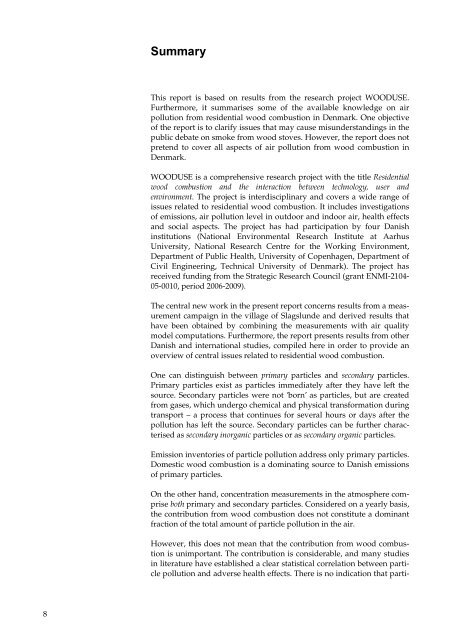Brændefyrings bidrag til luftforurening - DCE - Nationalt Center for ...
Brændefyrings bidrag til luftforurening - DCE - Nationalt Center for ...
Brændefyrings bidrag til luftforurening - DCE - Nationalt Center for ...
You also want an ePaper? Increase the reach of your titles
YUMPU automatically turns print PDFs into web optimized ePapers that Google loves.
8<br />
6XPPDU\<br />
This report is based on results from the research project WOODUSE.<br />
Furthermore, it summarises some of the available knowledge on air<br />
pollution from residential wood combustion in Denmark. One objective<br />
of the report is to clarify issues that may cause misunderstandings in the<br />
public debate on smoke from wood stoves. However, the report does not<br />
pretend to cover all aspects of air pollution from wood combustion in<br />
Denmark.<br />
WOODUSE is a comprehensive research project with the title 5HVLGHQWLDO<br />
ZRRG FRPEXVWLRQ DQG WKH LQWHUDFWLRQ EHWZHHQ WHFKQRORJ\ XVHU DQG<br />
HQYLURQPHQW The project is interdisciplinary and covers a wide range of<br />
issues related to residential wood combustion. It includes investigations<br />
of emissions, air pollution level in outdoor and indoor air, health effects<br />
and social aspects. The project has had participation by four Danish<br />
institutions (National Environmental Research Institute at Aarhus<br />
University, National Research Centre <strong>for</strong> the Working Environment,<br />
Department of Public Health, University of Copenhagen, Department of<br />
Civil Engineering, Technical University of Denmark). The project has<br />
received funding from the Strategic Research Council (grant ENMI-2104-<br />
05-0010, period 2006-2009).<br />
The central new work in the present report concerns results from a measurement<br />
campaign in the village of Slagslunde and derived results that<br />
have been obtained by combining the measurements with air quality<br />
model computations. Furthermore, the report presents results from other<br />
Danish and international studies, compiled here in order to provide an<br />
overview of central issues related to residential wood combustion.<br />
One can distinguish between SULPDU\ particles and VHFRQGDU\ particles.<br />
Primary particles exist as particles immediately after they have left the<br />
source. Secondary particles were not ’born’ as particles, but are created<br />
from gases, which undergo chemical and physical trans<strong>for</strong>mation during<br />
transport – a process that continues <strong>for</strong> several hours or days after the<br />
pollution has left the source. Secondary particles can be further characterised<br />
as VHFRQGDU\ LQRUJDQLF particles or as VHFRQGDU\ RUJDQLF particles.<br />
Emission inventories of particle pollution address only primary particles.<br />
Domestic wood combustion is a dominating source to Danish emissions<br />
of primary particles.<br />
On the other hand, concentration measurements in the atmosphere comprise<br />
ERWK primary and secondary particles. Considered on a yearly basis,<br />
the contribution from wood combustion does not constitute a dominant<br />
fraction of the total amount of particle pollution in the air.<br />
However, this does not mean that the contribution from wood combustion<br />
is unimportant. The contribution is considerable, and many studies<br />
in literature have established a clear statistical correlation between particle<br />
pollution and adverse health effects. There is no indication that parti-

















